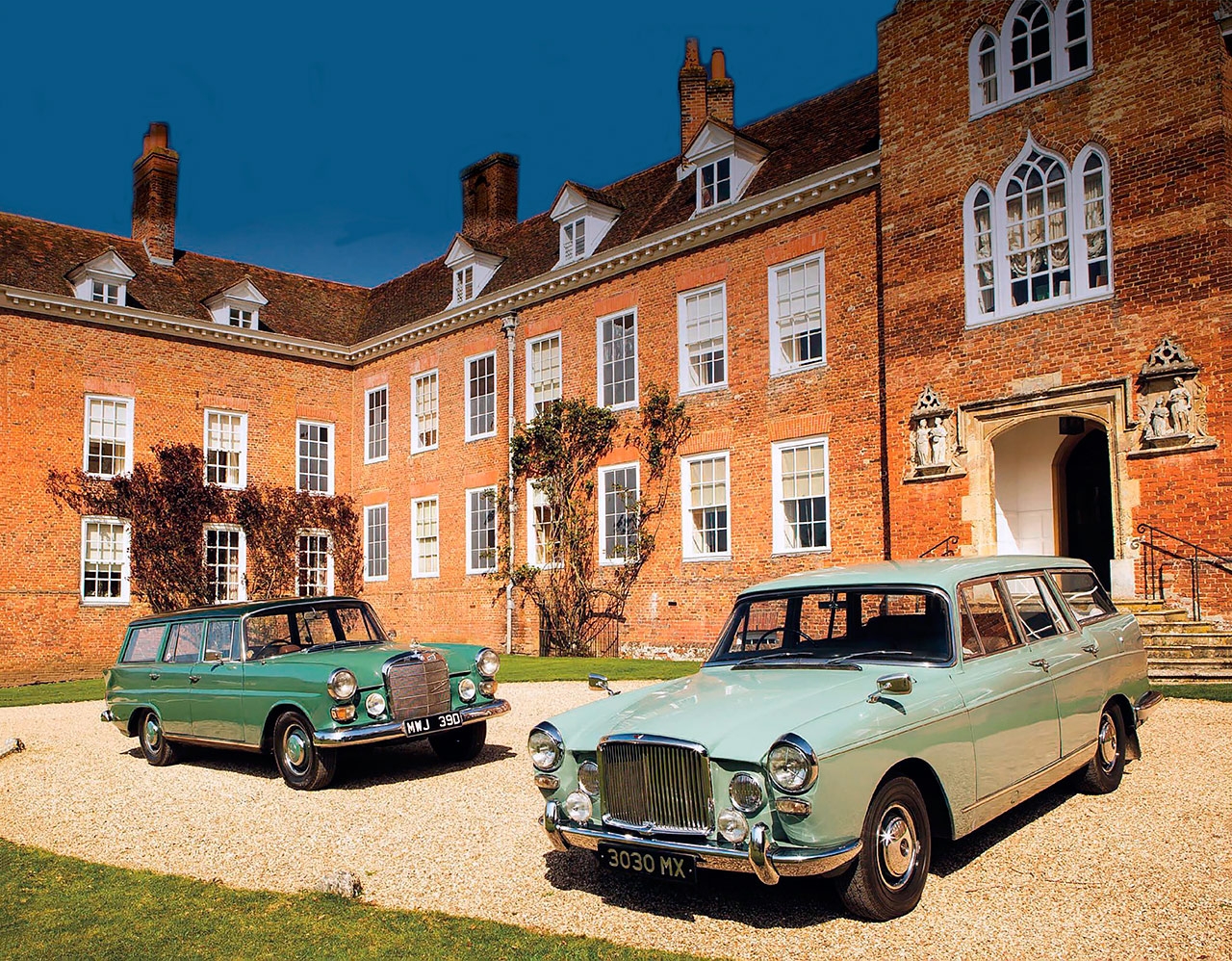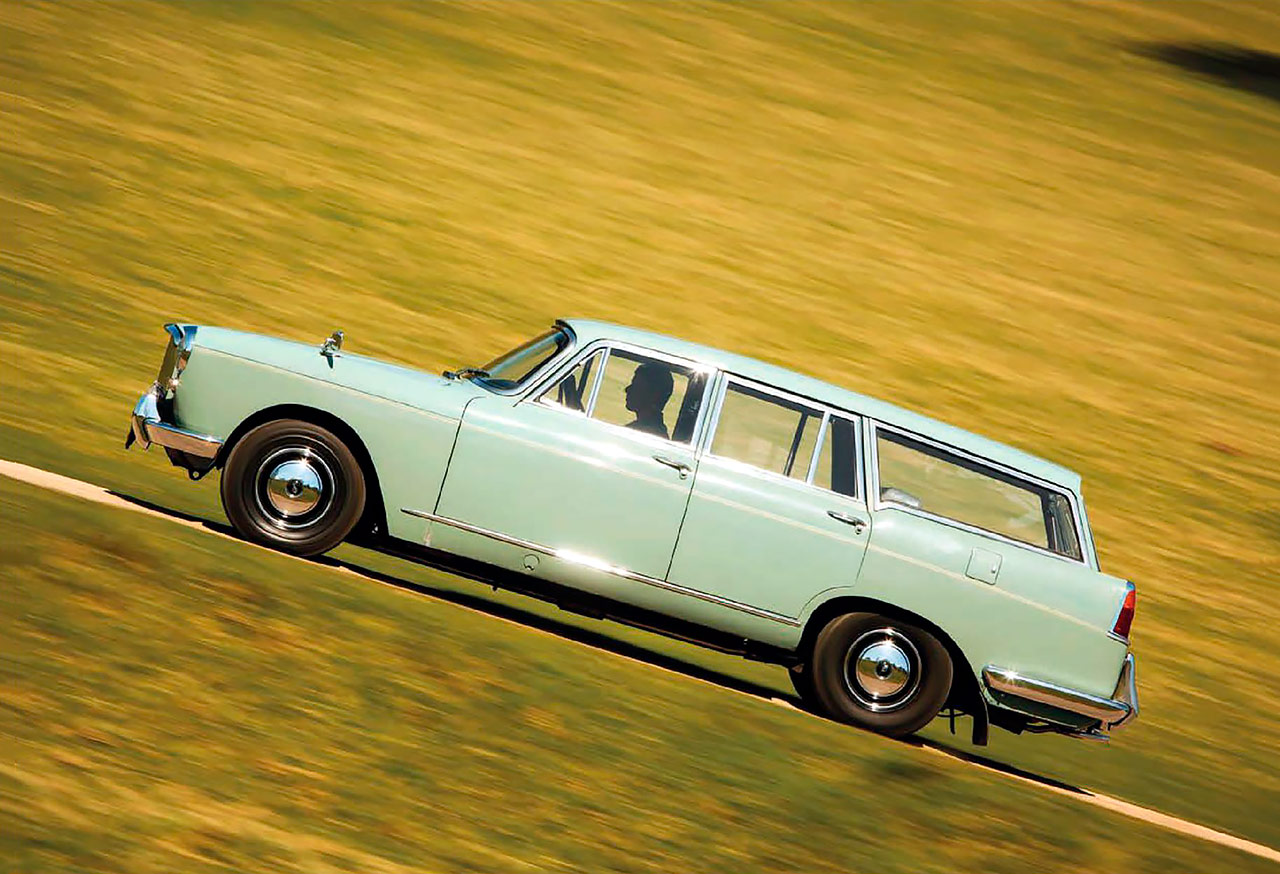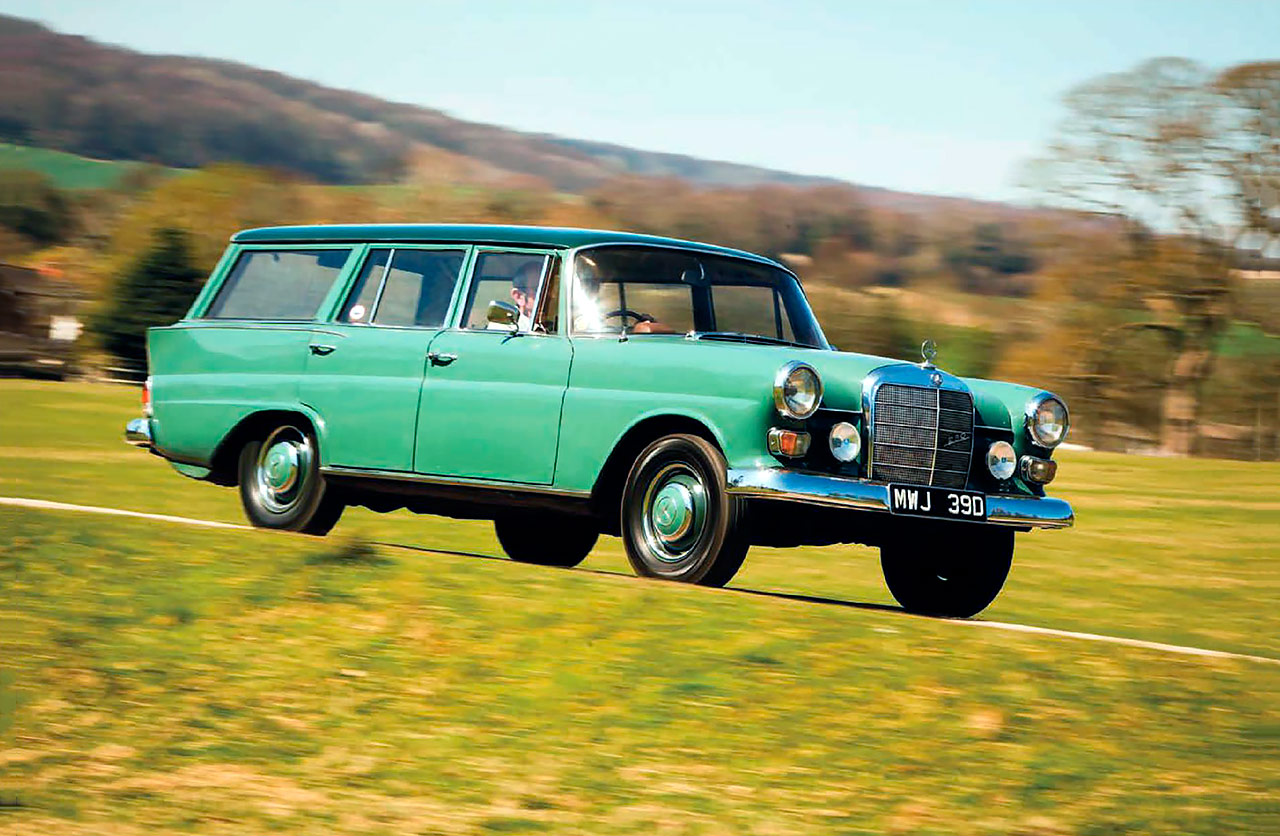
Beautifully Functional. Hand-built for discerning buyers, the Mercedes Universal and Vanden Plas Countryman are the zenith of ’60s estates, says Andrew Roberts. Photography Tony Baker. Universal vs Countryman Working wagons for the country set. Clash of the titans – Mercedes-BenzUniversal vs Vanden Plas Countryman.
There are a number of parallels between the two exceptionally rare and desirable shooting brakes basking in the magnificent grounds of Stonor Park in Oxfordshire. Both are coachbuilt, both are derived from middle-class saloon cars that made their debuts in 1959 and both have Belgian connections. But that is almost where the comparisons cease, because the Mercedes-Benz 230 Universal W110 and the Vanden Plas Princess 3-Litre Countryman are quite different forms of motoring life.
It is sometimes forgotten that Daimler-Benz would not offer a factory-built wagon until the W123 in 1977, but 20 years earlier the Borgward Isabella Combi had established the estate car as a respectable form of transport with no light commercial overtones. From 1955 the Mercedes Ponton had been available with a station wagon conversion by Binz of Lorch, and this tradition continued with the introduction of the fourcylinder W110 190c and 190Dc Fintails in 1961.

1961 Vanden-Plas Princess 3-Litre Countryman road test. Italianate styling of the Vanden Plas is supremely elegant and distinguished, although changes to the basic design took place only above the waistline.
Importateur des Moteurs et d’Automobiles (IMA) of Belgium – which had been assembling Mercedes saloons for the local market since 1954 – created its Universal estate in 1965, and in ’1966 West German dealers began to offer it as the first ‘official’ Mercedes station wagon.
The initial Universals were based on the 190 and 190D W110, and then, after the facelift of the Fintail range in the autumn of 1965, the 200, 200D, 230 and 230S. Floorpans and doors were shipped from Sindelfingen and the engines from Untertürkheim. In addition to fabricating a new roof, rear panels, inner rear wings and tailgate, IMA also used several Belgian-sourced materials, such as the glass. The weight penalty compared to the saloon was a mere 105kg and all Universals, apart from the 190, had an IMA-developed selflevelling air-suspension system to compensate for any extra load. Options included a third row of seats, a 60:40 split rear backrest, a bench front seat and automatic transmission.

Clockwise, from left: rear lights are blended into the fins; stylish script on tail; luggage area less practical than that of the Mercedes; VdP’s torquey, long-stroke six-cylinder C-series is shared with Big Healey
One challenge to Universal sales in Germany was the belief among some potential owners that IMA’s corrosion protection was not on a par with that of Daimler-Benz, but cost was also an issue. Belgian-market Fintails were 40% cheaper than the German models but kombis attracted a 30% premium over the saloon. Their foreign construction, meanwhile, added a further 10% import duty. Motorists on a budget who wanted a six-cylinder five-door wagon could have gone for the less prestigious – but equally less pricey – Ford Taunus P5 Turnier, while there were strong four-cylinder rivals in the form of the Citroën Safari, Volvo Amazon and Peugeot 404. The Universal inevitably remained an exclusive sight until production ceased in early 1968. IMA subsequently built a five-door version of the W114/115 and continued to assemble Mercedes saloons until 1973.
The most frequently converted Fintail was the 200D, and only 639 examples of the 230 Universal left the Malines plant (compared to a total of 40,258 standard four-doors). That makes ‘our’ 1966 example an exceptionally rare motor car, but even more unusually it is a Britishmarket version. During the early ’60s, the UK’s import regulations inflated the price of a standard 190 saloon to £1500, so the chances of ever purchasing a shooting brake based on the 230 would have been as fantastic for the average motorist as a typical episode of Danger Man.
Robert Coxshall came across MWJ 39D after it had been lying, unloved, for about 10 years: “It wanted a lot of bringing back. It was running, but work was needed to the brakes and clutch. Kombis were offered in single-tone finishes and this car was originally supplied in blue, but was painted green in around 1999. The darker shade to the roof was added after that.”

1965 Mercedes-Benz 230 Universal W110. Clockwise, from main: neat Universal combines the short-nose Fintail body with a lusty straight-six engine; rear light clusters are unique to the estate.
When the Mercedes joined the Coxshall fleet, he believed it to be the only right-hand-drive British-market Universal on the road, and it certainly manages the rare trick of being even more imposing than the saloon – thanks in part to being 1½in taller than a standard Fintail. The detailing of the coachwork is exquisite, from the triangular rear lights that are unique to the estate, to the carefully altered doors. In terms of spares, though, rear panels are hard to get hold of, as are window glass and rubbers.
There are the carefully considered touches to the cabin, too, including demister vents for the side windows. This was also one of the few tests where I would have welcomed rain – if only for an excuse to experience those distinctive ‘clap hands’ wipers. Wisely, I didn’t impart that particular thought to the photographer.
The 230 combines the M180 straight-six with the shorter bonnet of the 190c, resulting in modest decadence with immense practicality. It is also a reminder that big European cars of the ’60s did not automatically have to handle like RMS Queen Mary. The steering is low-geared and light at low speeds, making the Universal as suited to town use as to crossing continents. The gearchange, meanwhile, is an object lesson that a four-on-the-column does not have to be a Ford Consul-style nightmare. Coxshall reports that the 230 is “much of a muchness with the saloon”, although he says that the 15in (rather than 13in ) wheels make all the difference.
As for the Mercedes’ rival for the title of ‘Most Desirable ’60s Shooting Brake’, it is often forgotten how the Vanden Plas is a ménage of two distinctive design idioms. The modest fins betray Italian-American stylistic tropes of the late ’50s but are combined with a ‘traditional’ radiator grille and interior. The fact that the 3-Litre saloon is an undeniably handsome vehicle is testament to both Pininfarina and the Kingsbury works, and the estate conversion does nothing to mar the VdP’s styling. The long side glass and roofline enhance the shape, and the result is a vehicle that seamlessly blends cad and curmudgeon – transport equally suited for Denholm Elliott and James Robertson Justice.

Mercedes’ cabin is solidly functional, the vertical speedo being the only unusual touch. Below: VdP cabin is about traditional upper-class opulence. From above: additional driving lights add to the Mercedes’ appeal as a car for hauling loads and passengers over long distances; radiator grille is topped by the threepointed star but the Universal station wagon was the brainchild of a Belgian company.
This ’1962 Countryman is based on the 3-Litre Princess MkII, which was introduced in late ’1961 and derived from the Austin A110 Westminster. Compared to its predecessor, there was a more powerful engine, uprated suspension, a longer wheelbase and a floor-mounted gearlever for manual versions. In that same year, BMC, evidently vexed that Her Majesty The Queen should favour a Vauxhall PA Cresta Friary – a car more easily associated with successful fruit importers from Southampton than royalty – had Kingsbury convert a Princess into a station wagon. The experiment proved successful and a handful of cars – possibly as few as six – was subsequently transformed, including a 4 Litre R that entered service at the Royal Mews.
In addition, according to Bill Price of the BMC rally team: “Longbridge built maybe two or three Austin Westminster estate prototypes. One was offered to Stuart Turner, and an A110 wagon was used on the Rallye Vltava in 1965.” It was also the case that the 1956-’59 Austin A95 had been available as a rather attractive Countryman, but BMC decided not to replace it with an A110/6/110/Princess 3-Litre successor.
Given how imposing the Princess looks, this is a matter of some regret – an estate version would have expanded the model’s appeal, providing a strong rival to the Humber Hawk/Super Snipe, the Abbott Fords and the big Vauxhalls.
Steve Dale has owned 3030 MX “for 10 years at least”, saying that it very rarely comes out, but that he enjoys driving a car that is virtually unique on British roads. The 3-Litre is rumoured to have once been the transport of BMC’s top brass, both Leonard Lord and George Harriman having been mentioned.
The bottom half of the car is the same as the saloon, the coachwork differing only from the windows upwards. The suspension is also identical to the standard four-door Princess, although some estates were fitted with Selectaride rear dampers. As far as spares are concerned, with those parts that are unique to the Countryman – roof, back doors, etc – Dale reckons that “you are basically knackered”.
One pleasant difference from the standard car is the gearchange. The manual transmission of the 1961-’1964 Westminster, 6/110 and Princess was a three-speed floor shift with dual overdrive. It is a system that, in the opinion of this Big Farina enthusiast, arguably offers the worst of both worlds, being neither as accessible as that of the 6/99 nor blessed with the innate smoothness of the 4 Litre R. Dale’s car, however, is equipped with the four-speed unit from the Austin-Healey 3000, which, when combined with power steering – an option on the VdP from 1962 onwards – makes for a relaxed, if emphatically non-sporting journey.
The Countryman has all the elements so familiar to any aficionado of the 3-Litre Princess; the smooth ride, the sense of wallowing as a corner is negotiated and that commanding driving position from behind the vast steering wheel. Almost every detail of the Vanden Plas seeks to reassure, as evidenced by the sheer opulence of the trim. Motorists who craved excitement from their shooting brake could always have opted for a Slough-built DS Safari instead. But, just in case the proud owner had any delusions of grandeur, there are two elements to remind him of his East Cheam roots: the indicators are operated via a Mini-style flashing stalk, and the C-series engine makes any VdP sound like a Scotland Yard car at the conclusion of an Edgar Wallace Mystery. Above all, these two estates illustrate how definitions of ‘luxury’ can vary so widely. The Mercedes-Benz appears principally concerned with integrity of engineering rather than decoration. The tailfins may have been created to appeal to the US market and the vertical speedometer is undeniably a gimmick, but the ethos of the Universal remains one of durability.
The occupants are conveyed in comfort without any sense of being cossetted, while the driver is secure in the knowledge that the gearchange will be as slick and the engine as infallible after hundreds of thousands of miles. It did not matter whether your Fintail was a taxi in Lisbon, a longwheelbase 300SE transporting a diplomat along Berlin’s Wilhelmstraße, or a heavily laden Universal travelling across South Africa, the quality would be equally uncompromised.
As for the Vanden Plas, practicality would have probably been a far lesser consideration in its purchase; a Super Snipe estate was more than £1000 cheaper and, indeed, the A60 Countryman was highly capacious. In essence, it reminds me of the world of Ian Fleming’s novels that, in the words of historian David Cannadine, celebrated the ‘quintessential clubland hero, flourishing in the very era when they were deemed to be doomed’. Retired Brigadiers may have seen clear evidence of the decline of deference all around them, but in the Countryman’s walnut-veneered cabin of folding picnic tables and leather upholstered armchairs they were safely cocooned.
Either of these splendid vehicles would be eminently suited to touring the grounds of Stonor and it is impossible to choose a victor; they are not so much competitors, as complementary to each other. The Universal is elegant, efficient and ever so slightly menacing – equally suited to a new Germany of Brutalist concrete or a supporting role in a Le Carré or Deighton Cold War drama. But for a weekend of grouse shooting, a point-to-point race, or anyone just wanting to make an impact at the Young Farmers’ dance, little could match the Countryman. And that is why it would find a place in my garage, my social delusions notwithstanding.
Thanks to John Lakey, Bill Price and the Cambridge-Oxford Owners’ Club (www.co-oc.org); everyone at Stonor Park (www.stonor.com)
‘IT IS A REMINDER THAT BIG EUROPEAN CARS DIDN’T HAVE TO HANDLE LIKE RMS QUEEN MARY’
‘FOR A WEEKEND OF GROUSE SHOOTING, LITTLE COULD MATCH THE COUNTRYMAN’
TECHNICAL DATA FILE 1965 Mercedes-Benz 230 W110 Universal / W111/IA / Mercedes-Benz W110 Kombi
Sold/number built 1965-’1968/c2000
Construction steel monocoque
Engine iron-block, alloy-head, single-overhead-cam 2306cc straight-six, twin Solex carburettors
Max power 118bhp @ 5400rpm
Max torque 137lb ft @ 3800rpm
Transmission four-speed manual, RWD
Suspension: front unequal-length wishbones, coil springs, anti-roll bar rear single-joint, low-pivot swing axles, coil springs, horizontal compensator spring; telescopic dampers f/r
Steering recirculating ball
Brakes discs front, drums rear, with servo
Length 15ft 6 ½ in (4737mm)
Width 5ft 10 ½ in (1791mm)
Height 5ft (1524mm)
Wheelbase 9ft ¼ in (2750mm)
Weight 3108lb (1410kg)
0-60mph 16 secs
Top speed 103mph
Price new DM15,900
Price now £15,000
TECHNICAL DATA FILE 1961 Vanden Plas Countryman
Sold/number built 1961-’1964/six
Construction steel monocoque
Engine all-iron, overhead-valve 2912cc straight-six, twin SU carburettors
Max power 120bhp @ 4750rpm
Max torque 163lb ft @ 2750rpm
Transmission three-speed manual with overdrive, driving rear wheels
Suspension: front independent, by double wishbones, coil springs, telescopic dampers rear live axle with semi-elliptic leaf springs, lever-arm dampers, optional
Selectaride; anti-roll bar f/r
Steering cam and peg; optional assistance
Brakes discs front, drums rear, with servo
Length 15ft 8in (4788mm)
Width 5ft 8½in (1727mm)
Height 4ft 11in (1498mm)
Wheelbase 9ft 2in (2794mm)
Weight 3415lb (1549kg)
0-60mph 16.9 secs
Top speed 105mph
Price new c£3000
Price now £25,000





